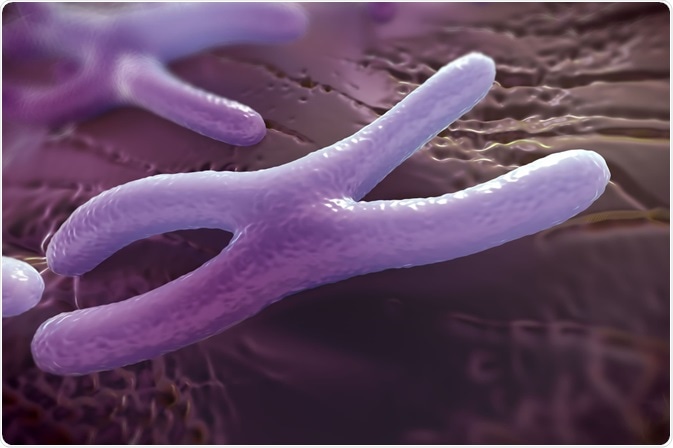Usher syndrome is a rare genetic disorder that affects approximately 1 in 25,000 babies and causes hearing and vision loss, often accompanied by balance problems. The syndrome accounts for 3-6% of all deaf children.
Hearing loss usually presents first, although the speed of progression to deafness can vary greatly between individuals. Retinitis pigmentosa initially causes problems in night vision and peripheral vision. The progressive degeneration of the retina leads to narrow tunnel vision and eventual blindness in most cases.

A 3D rendering of a chromosome. Image Credit: royaltystockphoto.com / Shutterstock
History
Usher syndrome was first reported by Albrecht von Gräfe in 1858, who noted a deaf patient with vision impairment and two brothers with identical symptoms, suggesting a genetic link. Richard Leibreich, a student of Gräfe, examine the condition in more detail and discovered that it followed a recessive pattern.
The condition is named after the British ophthalmologist, Charles Usher, who researched the specific pathology and transmission of the syndrome, with 69 patients taking part in his study.
Causes
There are ten different known gene mutations that can cause in Usher syndrome, which correspond to different types of the syndrome. It is also possible for a gene to mutate spontaneously without a hereditary link, but it is much more common for the gene mutation to be inherited from a parent.
The gene inheritance follows an autosomal recessive pattern, which means that both parents must be a carrier or affected by Usher syndrome for the child to have Usher Syndrome. Both males and females are affected equally as it is an autosomal trait.
Types
There are three types of Usher syndrome, as outlined below:
Type 1 is characterized by profound deafness from birth and severe balance problems. Hearing aids often provide little benefit and many children affected by Type 1 Usher syndrome need to rely on sign language, which is best begun as soon as possible when the child is most receptive to cognitive learning.
As a result of the difficulty with balance, most children take longer to learn to sit, stand and walk. On average, independent movement begins at approximately 18 months.
Development of problems in vision usually begins early in childhood and almost all children notice some effects by the age of ten. This initially presents as difficulty with night vision and tends to progress to complete blindness quite rapidly.
Type 2 is thought to be the most common type of Usher syndrome and children affected with this type are born with moderate to severe hearing loss. In most cases, hearing aids offer a tangible benefit and can assist children to communicate orally.
Vision loss usually presents and progresses more slowly than in Type 1 and many individuals do not notice the emergence of symptoms until their teen years.
Type 3 does not carry any particular symptoms at birth, although they develop later on. Over time senses of both hearing and sight get worse, although the rate at which this occurs varies greatly. It is common for individuals affected by this type to require hearing aids and suffer from significant vision loss or blindness in adulthood.
The syndrome type indicates when the symptoms initially present but do not necessarily match the severity of the disease.
Treatment
There is currently no cure for Usher Syndrome, although it may become a possibility in the future with genetic research pointing towards replacing the missing gene.
Early intervention is recommended to help individuals adjust to changes and manage the condition most effectively. Hearing aids can offer a notable benefit, as well as learning sign language and to read brail.
References
Further Reading
Last Updated: Mar 11, 2021